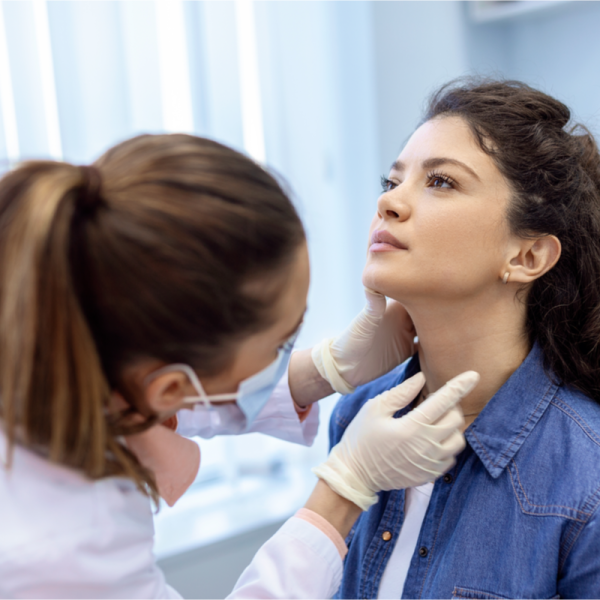
What is oropharyngeal squamous cell carcinoma?
Oropharyngeal squamous cell carcinoma refers to a tumour of the tonsils, the base and back of the tongue, the palate and also the side and back of the throat. More than 95 % of squamous cell carcinomas are oropharyngeal carcinomas. The most important risk factors are tobacco smoking and alcohol consumption. But the human papilloma virus, HPV for short, is also the main cause of this carcinoma nowadays.
What causes oropharyngeal squamous cell carcinoma?
About 60 % of oropharyngeal carcinomas are formed by HPV type 16. Those affected are getting younger and younger, as the average age used to be 57 years, but now it is 30 years to 55 years. This is due to the fact that HPV infection has emerged as an aetiology. The frequency of oral sex and the number of sexual partners are important risk factors here. HPV-positive patients are 16 times more likely to develop oropharyngeal carcinoma. In North America and Europe, HPV infections are responsible for about 70 to 80 % of these carcinomas.
As with the vast majority of tumours of the head and neck, HPV is not the cause in older men with an average age of 61. Alcohol and tobacco remain the greatest risk factors for oropharyngeal squamous cell carcinoma. People who smoke 1.5 or more packs of cigarettes a day have about a 3-fold increased risk. Patients who drink 4 or more alcoholic drinks a day have about a 7-fold increased risk of developing oropharyngeal squamous cell carcinoma. People who smoke a lot and drink a lot have 30 times the risk.
What are the symptoms of oropharyngeal squamous cell carcinoma?
Symptoms vary depending on the location of the oropharyngeal carcinoma, but usually include sore throat, odynophagia, dysphagia, dysarthria and earache. Another common symptom is cystic swelling of the throat. Because the symptoms of oropharyngeal carcinoma are similar to those of an upper respiratory infection, it can sometimes take several months before a patient is referred to a specialist.
How is oropharyngeal squamous cell carcinoma diagnosed?
Before treatment can be started, the first step is to make a diagnosis with the help of a laryngoscopy and a biopsy. Based on these examinations, the primary lesion can be evaluated and the secondary lesion can be searched for. If oropharyngeal squamous cell carcinoma is confirmed in a patient, this is followed by a CT scan of the neck with the use of contrast medium.
How is oropharyngeal squamous cell carcinoma treated?
Surgery is used as the primary treatment. Increasingly, TLM (transoral laser microsurgery) is used for this purpose, which allows carcinomas of the base of the tongue and tonsils to be excised endoscopically and thus removed. This can avoid the morbidity of open surgery. An increasingly popular procedure for treating an oropharyngeal lesion is TORS (transoral robotic surgery). In this method, a robot with several adapted arms is controlled by a surgeon via a console. Thanks to the endoscopic camera, which is inserted through the patient's mouth, a better visibility of the structures is possible.
Radiotherapy combined with chemotherapy can be used postoperatively or as primary therapy. In the past, radiotherapy was used for early-stage carcinomas and chemotherapy for more advanced carcinomas. Nowadays, IMRT (intensity-modulated radiotherapy) is increasingly used. This makes it possible to spare surrounding tissue and reduce long-term consequences and side effects.
Since the oral cavity and pharynx have a lot of lymphatic vessels, metastases are particularly frequent in the cervical lymph nodes. Therefore, metastasis must be considered in all people with oropharyngeal carcinoma. If metastases to the cervical lymph nodes cannot be eliminated by radiotherapy or radiochemotherapy, a neck dissection is justified after treatment.
What is the aftercare of oropharyngeal carcinoma?
During follow-up, it is important to keep intervals of 3 months for the 1st and 2nd year and 6 months for the 3rd to 5th year, even if the patient is free of symptoms. An individual, risk-adapted follow-up plan should be drawn up for each patient. It is equally important to ask regularly about pain and quality of life. After the 5th year, the usual screening measures should be applied.
The HPV status of the patient and the carcinoma should have no influence on the intervals of follow-up. In the case of a very high risk of recurrence, follow-up for the 1st and 2nd year at 6 to 8 week intervals is recommended. Follow-up in the following 3 years should be at three-month intervals. The following factors indicate a particularly high risk of recurrence:
The first two years after the occurrence of the carcinoma
- Lymph node recurrence
- Age of the patient under 45 years at initial diagnosis
- Continued use of tobacco and/or alcohol
- Tumour thickness greater than 5 mm
- Perineural invasion
- High T classification (T3 and T4)
- High pN classification (from N2)
- extracapsular spread
What is the prognosis for oropharyngeal squamous cell carcinoma?
Overall, the 5-year survival rate is about 60 %. However, this prognosis depends on the cause. People who test HPV positive have a 5-year survival rate of more than 75% and a 3-year survival rate of almost 90%. HPV-negative tested patients, on the other hand, have a 5-year survival rate of less than 50 %. Due to the favourable biology of the carcinoma as well as the usually younger age of the patients, HPV-positive carcinomas contribute to the higher survival rate. However, p16 expression can significantly improve prognosis for both HPV-positive and HPV-negative oropharyngeal carcinomas.
